Graph Attention Network for Lane-Wise and Topology-Invariant Intersection Traffic Simulation
IF 7.9
1区 工程技术
Q1 ENGINEERING, CIVIL
IEEE Transactions on Intelligent Transportation Systems
Pub Date : 2025-03-10
DOI:10.1109/TITS.2025.3546810
引用次数: 0
Abstract
Traffic congestion poses significant economic, environmental, and social challenges. High-resolution loop detector data and signal state records from Automated Traffic Signal Performance Measures (ATSPM) offer new opportunities for traffic signal optimization at intersections. However, additional factors such as geometry, traffic volumes, Turning-Movement Counts (TMCs), and human driving behaviors complicate this task. Existing simulators (e.g., SUMO, Vissim) are computationally intensive, while machine learning models often lack lane-specific traffic flow estimation. To address these issues, we propose two computationally efficient Attentional Graph Auto-Encoder frameworks as “Digital Twins” for urban traffic intersections. Leveraging graph representations and Graph Attention Networks (GAT), our models capture lane-level traffic flow dynamics at entry and exit points while remaining agnostic to intersection topology and lane configurations. Trained on over 40,000 hours of realistic traffic simulations with affordable GPU parallelization, our framework produces fine-grained traffic flow time series. This output supports critical applications such as estimating Measures of Effectiveness (MOEs), scaling to urban freeway corridors, and integrating with signal optimization frameworks for improved traffic management.求助全文
约1分钟内获得全文
求助全文
来源期刊

IEEE Transactions on Intelligent Transportation Systems
工程技术-工程:电子与电气
CiteScore
14.80
自引率
12.90%
发文量
1872
审稿时长
7.5 months
期刊介绍:
The theoretical, experimental and operational aspects of electrical and electronics engineering and information technologies as applied to Intelligent Transportation Systems (ITS). Intelligent Transportation Systems are defined as those systems utilizing synergistic technologies and systems engineering concepts to develop and improve transportation systems of all kinds. The scope of this interdisciplinary activity includes the promotion, consolidation and coordination of ITS technical activities among IEEE entities, and providing a focus for cooperative activities, both internally and externally.
 求助内容:
求助内容: 应助结果提醒方式:
应助结果提醒方式:


